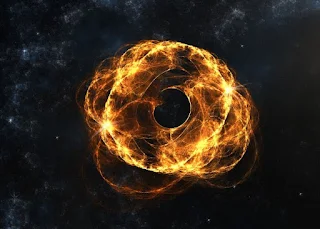Here are the 10 Most Mysterious Phenomena in Space that you should know, OK, just check it out:
Galactic Collisions
It turns out that galaxies can "eat" each other. What's even more surprising is that the Andromeda galaxy is moving closer to our Milky Way galaxy. The image above is a simulation of the collision of Andromeda and our galaxy, which will occur in about 3 billion years.
Quasar
Quasars seem to sparkle at the edge of the universe that we can see. This object released energy equivalent to the energy of hundreds of galaxies combined. It could be that a quasar is an enormous black hole in the heart of a distant galaxy. This image is of quasar 3C 273, photographed in 1979.
Dark Matter
Scientists believe that dark matter is the largest constituent of the universe, but cannot be seen and detected directly by current technology. Candidates range from heavy neutrinos to invisible black holes. If dark matter does exist, we still need a better knowledge of gravity to explain this phenomenon.
Gravity Waves Gravitational
waves are distortions of the structure of space-time predicted by Albert Einstein's general theory of relativity. The waves travel at the speed of light, but are weak enough that scientists hope to detect them only through colossal cosmic events, such as the merging of two black holes in the image above. LIGO and LISA are two detectors designed to observe these elusive waves.
Energy Vacuum
Quantum Physics tells us that the opposite of appearances, empty space is an artificial bubble of “virtual” subatomic particles that are constantly being created and destroyed. Particles occupying every cubic centimeter of space with a certain energy, according to the general theory of relativity, produce an anti-gravity force that makes space expand even more. Until now no one really knew the cause of the expansion of the universe.
Mini Black Holes
If the new and radical "braneworld" theory of gravity proves correct, then thousands of mini black holes are scattered throughout our solar system, each the size of an atomic nucleus. Unlike black holes in general, these mini black holes are remnants of the Big Bang and affect space and time in different ways.
Neutrinos
Neutrinos are massless and uncharged elementary particles that can penetrate metal surfaces. Several neutrinos are passing through your body as you read this.
These "phantom" particles are produced in the core of stars and supernova explosions. Detectors are placed beneath the earth's surface, below sea level, or into large chunks of ice as part of the IceCube, a special project to detect the presence of neutrinos.
Extrasolar Planets (Exoplanets)
Until the early 1990s, we only knew the planets in our own solar system. However, astronomers have now identified more than 200 extrasolar planets that are outside our solar system. Searching the Earth both seem to have failed until now. Astronomers generally believe that better technology is needed to discover some worlds like Earth.
Cosmic Background
Radiation This radiation is also called the Cosmic Microwave Background (CMB) which is the residual radiation that occurred when the Big Bang gave birth to the universe. It was first detected in the 1960s as visible radio noise scattered throughout the universe.
CBM is considered the most important evidence of the truth of the Big Bang theory. Accurate measurements by the WMAP project show that the CMB temperature is -455 degrees Fahrenheit (-270 Celsius).
Antimatter
Like Superman's evil side, Bizzaro, particles (normal matter) also have an opposite version of themselves called antimatter. For example, an electron has a negative charge, but the antimatter positron has a positive charge.
Matter and antimatter will annihilate each other when they collide and their mass will be converted into energy by Einstein's equation E=mc2. Some spacecraft designs incorporate antimatter engines.

